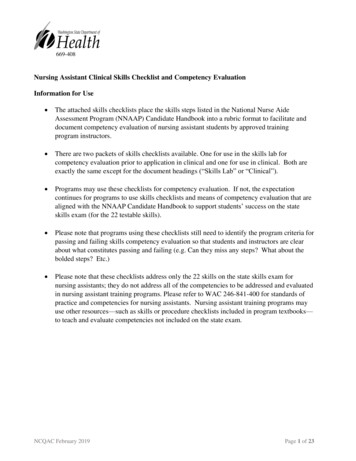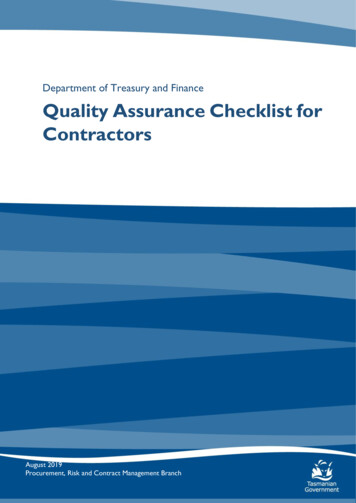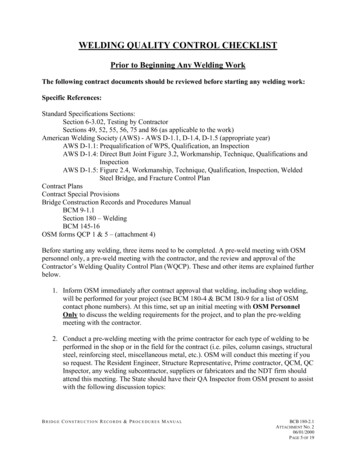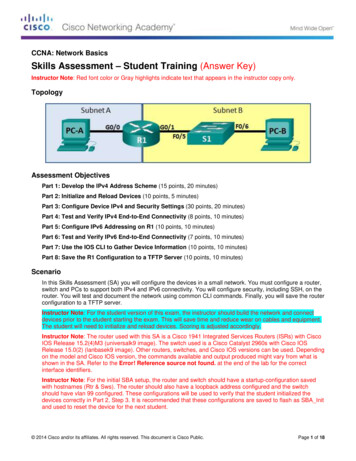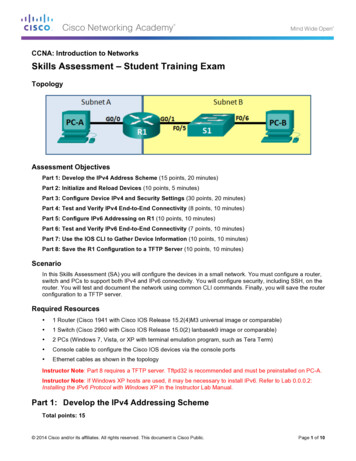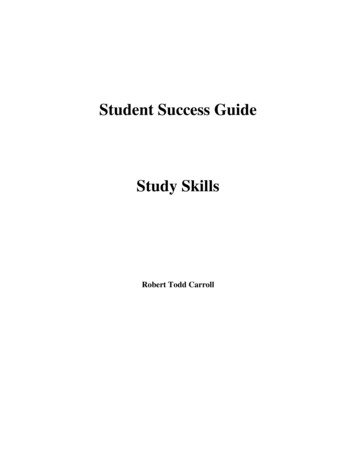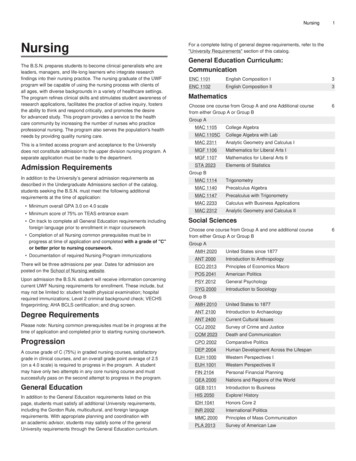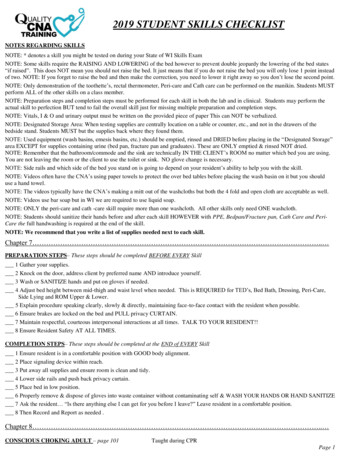
Transcription
2019 STUDENT SKILLS CHECKLISTNOTES REGARDING SKILLSNOTE: * denotes a skill you might be tested on during your State of WI Skills ExamNOTE: Some skills require the RAISING AND LOWERING of the bed however to prevent double jeopardy the lowering of the bed states“if raised”. This does NOT mean you should not raise the bed. It just means that if you do not raise the bed you will only lose 1 point insteadof two. NOTE: If you forget to raise the bed and then make the correction, you need to lower it right away so you don’t lose the second point.NOTE: Only demonstration of the toothette’s, rectal thermometer, Peri-care and Cath care can be performed on the manikin. Students MUSTperform ALL of the other skills on a class member.NOTE: Preparation steps and completion steps must be performed for each skill in both the lab and in clinical. Students may perform theactual skill to perfection BUT tend to fail the overall skill just for missing multiple preparation and completion steps.NOTE: Vitals, I & O and urinary output must be written on the provided piece of paper This can NOT be verbalized.NOTE: Designated Storage Area: When testing supplies are centrally location on a table or counter, etc., and not in the drawers of thebedside stand. Students MUST but the supplies back where they found them.NOTE: Used equipment (wash basins, emesis basins, etc.) should be emptied, rinsed and DRIED before placing in the “Designated Storage”area EXCEPT for supplies containing urine (bed pan, fracture pan and graduates). These are ONLY emptied & rinsed NOT dried.NOTE: Remember that the bathroom/commode and the sink are technically IN THE CLIENT’s ROOM no matter which bed you are using.You are not leaving the room or the client to use the toilet or sink. NO glove change is necessary.NOTE: Side rails and which side of the bed you stand on is going to depend on your resident’s ability to help you with the skill.NOTE: Videos often have the CNA’s using paper towels to protect the over bed tables before placing the wash basin on it but you shoulduse a hand towel.NOTE: The videos typically have the CNA’s making a mitt out of the washcloths but both the 4 fold and open cloth are acceptable as well.NOTE: Videos use bar soap but in WI we are required to use liquid soap.NOTE: ONLY the peri-care and cath -care skill require more than one washcloth. All other skills only need ONE washcloth.NOTE: Students should sanitize their hands before and after each skill HOWEVER with PPE, Bedpan/Fracture pan, Cath Care and PeriCare the full handwashing is required at the end of the skill.NOTE: We recommend that you write a list of supplies needed next to each skill.Chapter 7 . PREPARATION STEPS– These steps should be completed BEFORE EVERY Skill1 Gather your supplies.2 Knock on the door, address client by preferred name AND introduce yourself.3 Wash or SANITIZE hands and put on gloves if needed.4 Adjust bed height between mid-thigh and waist level when needed. This is REQUIRED for TED’s, Bed Bath, Dressing, Peri-Care,Side Lying and ROM Upper & Lower.5 Explain procedure speaking clearly, slowly & directly, maintaining face-to-face contact with the resident when possible.6 Ensure brakes are locked on the bed and PULL privacy CURTAIN.7 Maintain respectful, courteous interpersonal interactions at all times. TALK TO YOUR RESIDENT!!8 Ensure Resident Safety AT ALL TIMES.COMPLETION STEPS– These steps should be completed at the END of EVERY Skill1 Ensure resident is in a comfortable position with GOOD body alignment.2 Place signaling device within reach.3 Put away all supplies and ensure room is clean and tidy.4 Lower side rails and push back privacy curtain.5 Place bed in low position.6 Properly remove & dispose of gloves into waste container without contaminating self & WASH YOUR HANDS OR HAND SANITIZE7 Ask the resident “Is there anything else I can get for you before I leave?” Leave resident in a comfortable position.8 Then Record and Report as needed .Chapter 8 . CONSCIOUS CHOKING ADULT – page 101Taught during CPRPage 1
Chapter 6 . HAND WASHING – page 70 NOTE: Sanitizing is done at the start and completion of each skill unless otherwise noted.HANDWASHING is only necessary upon completion of PPE, Bedpan/Fracture pan, Cath Care, Peri-Care*1 Remove your watch, or push it up on your forearm, and roll up or push up your sleeves. Ensure uniform and hands do NOT touch sink.2 Turn on the water at sink and adjust the temperature until it is comfortably warm.3 Place BOTH hands under the running water to COMPLETELY wet hands and wrists thoroughly keeping them lower than your elbows.4 Apply antimicrobial soap from the dispenser to your hands.5 Interlace fingers pointing downwards while rubbing your hands together vigorously to work up a lather.6 Lather all surfaces of wrists, hands, fingers and nails producing friction for at least 20 (twenty) seconds.7 Grasp wrists and circle with your other hand, scrub palms, backs of hands, areas between fingers.8 Clean fingernails by rubbing fingertips against palms of the opposite hand.9 After lathering for at least 20 (twenty) seconds, rinse all surfaces of wrists, hands, and fingers keeping hands lower than theelbows and the fingertips down.10 Use a clean, dry paper towel/towels to dry all surfaces of hands, wrists, and fingers then dispose of paper towel into waste container.11 Use another clean, dry paper towel to turn off faucet then dispose of paper towel into waste container or uses knee/foot control to turnoff faucet. Exit by opening the door with your hip or shoulder. If there is a handle use another clean paper towel to open the door.12 Do not touch inside of sink at any time. DO NOT RE-CONTANMINATE HANDS AT ANY POINT DURING PROCEDURE!*HAND SANTIZE / HAND HYGIENE – page 701 Cover ALL surfaces of hands with hand sanitizer.2 Rub hands together until hands are COMPLETELY DRY!* DONNING AND REMOVING PPE (GOWN AND GLOVES) Empty Urinary Bag and WASH HANDS– page 721 SANTIZE HANDS then pick-up gown, unfold, and slide your arms through each sleeve; keeping opening of the gown in back.2 Securely fasten the ties at the back of your neck and waist making sure the back of clothing is covered by gown (as much as possible).3 Put the mask over mouth and nose then bend nose wire. Tie the top strings behind your head, then tie the bottom strings or place elasticloops around ears. Adjust for comfort. (NOT WORN DURING TESTING)4 Place the earpieces of the glasses over your ears or the headband around your head and adjust. (NOT WORN DURING TESTING)5 Inspect both gloves carefully for tears. Put gloves on carefully so they do not tear and pull the gloves up over the cuffs of gown.6 Enter room and complete the preparation steps.7 Empty urinary drainage bag as taught in that skill & memorize the output, then complete the completion steps.(RECORD output AFTER removing PPE and washing your hands)8 Before removing gown, with one gloved hand, grasps the other glove at the palm, and slightly tug, pull or FOLD cuff so the cuff ofthe glove is located below the cuff of the gown to make it easy to slip your fingers from your opposite hand under the cuff of the glovewithout touching the gown. (contaminating yourself).9 Using your fingertips from the now half-gloved hand, grasp the opposite gloved hand at the heel of hand, remove gloveturning it inside out. Dispose of glove or roll into a ball in the palm of the still half-gloved hand.10 Slip fingers from the ungloved hand under the cuff of the remaining glove at the wrist touching only the clean inside of theglove and the bare wrist to ensure you do NOT contaminate yourself. Remove glove turning it inside out as it is removed.11 Dispose of gloves into designated waste container without contaminating yourself.12 Touching only the earpieces or the head band, remove safety glasses and place in appropriate container.13 Carefully remove the gown without touching the outside of the gown. Unfasten the gown at the neck and then at the waist.14 Pull one sleeve over fingertips by slipping your fingers from opposite hand under the cuff at the wrist.15 Then grasp the other sleeve with covered hand, pull it over your fingertips, Hold your arms out and away from your body to ensure itdoes NOT touch the floor. Continue to bring the gown forward rolling it into a ball as you pull it off.16 Dispose of gown in designated container without contaminating self .17 Remove mask by untying the bottom strings, then the top strings or pull elastic loops from around ear. Hold by strings and dispose.18 Perform HAND WASHING as directed in that skill.19 RECORD OUTPUTPage 2
HANDLING A BIOHAZARDOUS PLASTIC TRASH BAG – page 75Single Bag:1 Open trash bag and make a cuff around top edge by placing your hands several inches down on the outside of bag and pull outward.2 Place bag within easy reach of work area.3 When done, close by putting fingers under cuffed edge and pull edges together, touching only the outside of the bag and tie with knot.Double Bag:1 Arrange with a co-worker to assist.2 Remove trash/linen bag and carry to door of room.3 Outside the door, co-worker holds up a cuffed bag and you place your bag into the clean bag without touching the clean bag.4 Co-worker closes bag, ties top edge in knot, and carries to designated disposal area.Chapter 9 . * COUNT & RECORDS RADIAL PULSE AND RESPIRATIONS page 116 Testing Set up: Patient is sitting upright in chair1 Preparation Steps2 Make sure the person is in a comfortable, relaxed position with arm in resting position.3 Locate the radial artery by gently pressing 2 - 3 fingers on the inside of the wrist on the same side as the thumb.4 Using a second hand count beats for one full minute. Cue Instructor/observer when you are going to start and again when you end.5 Note the rhythm and force of the pulse.6 Record the pulse rate. (Note: When testing you must be within plus or minus 4 beats of evaluator’s reading).7 Count respirations for one full minute. Cue Instructor/observer when you are going to start and again when you end.8 Note the rhythm and depth of the respirations and whether the client is having difficulty breathing.9 Record the respiration rate (Note: When testing you must be within plus or minus 2 breaths of evaluator’s reading).10 Completion StepsCOUNT & RECORDS Apical PULSE* – page 118USING AN ORAL THERMOMETER – page 116 (Remember RED is for RECTAL, BLUE is for ORAL)1 Preparation Steps2 Place client in Fowler’s position.3 Inspect thermometer to ensure it is not broken or damaged in any way.4 Apply proper thermometer sheath (NOTE: If using glass, first shake so mercury-like substance is below 94 degrees).5 Place thermometer bulb slightly to one side under tongue and ask person to close lips around thermometer.6 While waiting, open an alcohol wipe pad to prepare for cleaning the thermometer when skill is complete.7 Wait 3 minutes for a glass thermometer or until electric thermometer beeps then remove thermometer, discard sheath.8 Read thermometer and clean with alcohol wipe.9 Place thermometer on clean dry paper towel or back in the proper container.10 Record temperature and finish with Completion StepsUSING A TYMPANIC THERMOMETER – page 1161 Preparation Steps2 Place client in Supine or Fowler’s Position.3 Remove probe from machine.4 Apply proper thermometer sheath and turn on thermometer.5 Grasp top of client’s ear and pull up and back for an adult (down and back for a child).6 Insert probe into ear canal, pointing down and forward towards the person’ nose.7 When you hear the beep, remove thermometer, and read the screen.8 Eject probe cover into trash, wipe clean with alcohol wipe and place back into the proper container.9 Record temperature and finish with Completion Steps.Page 3
USING AN RECTAL THERMOMETER – page 116 (Remember RED is for RECTAL, BLUE is for ORAL)1 Preparation Steps2 Place client in Side Lying Position with top knee flexed.3 Inspect thermometer to ensure it is not broken or damaged in any way.4 Apply proper thermometer sheath (NOTE: If using glass, first shake so mercury-like substance is below 94 degrees).5 Lubricate the tip of the probe by placing a small amount of jelly on a tissue and dipping the tip of probe in it.6 Adjust covers to expose buttocks. Lift the client’s upper buttock and insert the probe into the anus no more than 1 inch for an adultand ½ inch for a child. Stay with the client and hold the probe in place.7 Wait 3 minutes (if using a digital hold in place until it beeps) then remove thermometer, discard sheath using toilet paper.8 Read thermometer and clean with alcohol wipe.9 Place thermometer on clean dry paper towel or back in the proper container.10 Record temperature and finish with Completion Steps.MEASURE & RECORD HEIGHT OF AMBULATORY CLIENT – page 123 (NOTE: No paper towel is used)1 Preparation Steps2 Ensure client has nonskid footwear on, then walk with client to the scale.3 Before client stands on scale, raise height bar to highest position.4 Assist person to stand on scale.5 Flip height rod up and slide down until it touches top of head.6 Assist client off scale.7 Record height based on indicator on scale and finish Completion Steps.Note: If client cannot stand/walk, use tape measure to measure from top of head to bottom of feet while person is in supine position on bed.*MEASURE& RECORD WEIGHT OF AMBULATORY CLIENT– page 123 (NOTE: No paper towel is used)1 Preparation Steps (Note: When testing the client is sitting upright in a chair with nonskid footwear on)2 Ensure client has nonskid footwear on, then assist client to a standing position by offering them an arm (NOTE: Client pulls on yourarm/elbow, you should NOT pull on their arm or shoulder) and walk WITH client to the scale.3 Balance the scale to zero and assist client onto the scale. Ensure client is centered with their arms at
NOTE: Videos often have the CNA’s using paper towels to protect the over bed tables before placing the wash basin on it but you should use a hand towel. NOTE: The videos typically have the CNA’s making a mitt out of the washcloths but both the 4 fold and open cloth are acceptable as well.

